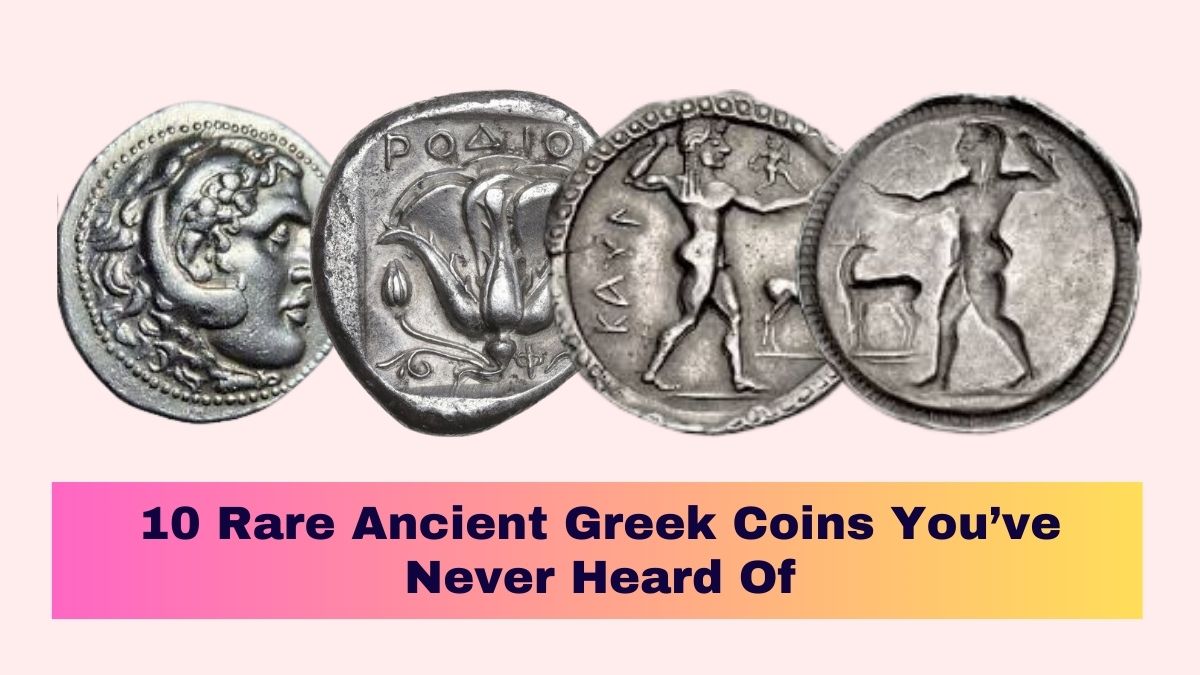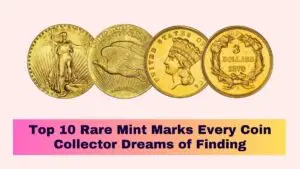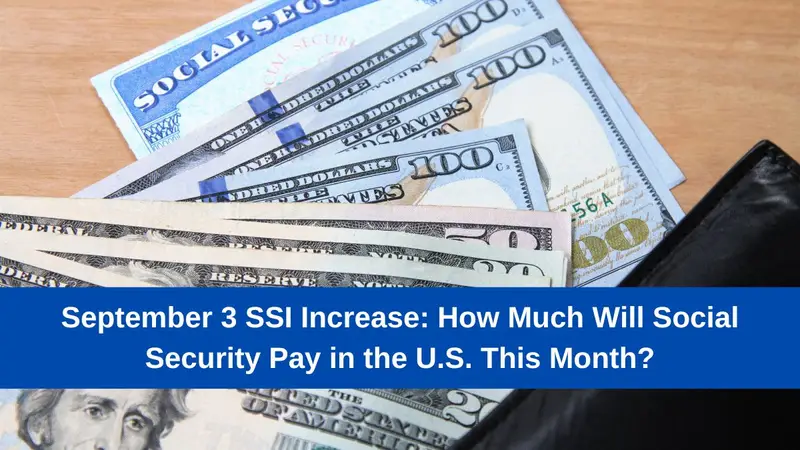Ancient Greek coins offer a fascinating glimpse into the world of antiquity, representing not only currency but also the culture, politics, and mythology of various Greek city-states.
While many may be familiar with the iconic coins like the Athenian Owl, there exists a treasure trove of lesser-known, rare coins that hold immense value for collectors and historians alike.
In this article, we’ll delve into 10 rare ancient Greek coins you’ve probably never heard of, each with its own unique story and significance.
10 Rare Ancient Greek Coins You’ve Never Heard Of
1. Silver Stater of Melos (450-40 BC)
- Origin: Melos Island
- Features: The obverse of the coin displays an apple, a pun on the island’s name (Melos means “apple” in Greek). The reverse typically features an incuse square with a cross.
- Significance: The apple was chosen to symbolize the island itself, acting as a clever wordplay for a mostly illiterate population at the time.
2. Cnossus Silver Stater (350-300 BC)
- Origin: Crete
- Features: This coin is famous for its reverse image of a labyrinth, a nod to the mythological Minotaur and King Minos’ legendary labyrinth.
- Significance: The labyrinth symbolizes Crete’s ancient power and mythical past, particularly connected to the famous tale of Theseus and the Minotaur.
3. Gortyna Silver Stater (350-22 BC)

- Origin: Gortyna, Crete
- Features: This coin depicts the myth of Europa being abducted by Zeus in the form of a bull, representing one of the most famous Greek myths.
- Significance: The myth of Europa is essential as it not only inspired ancient festivals in Gortyna but also lent her name to the continent of Europe.
4. Silver Drachm of Chios (5th Century BC)
- Origin: Chios
- Features: The obverse side features Apollo, the god of music and prophecy, while the reverse depicts a lyre, symbolizing musical harmony.
- Significance: This coin reflects the island’s dedication to Apollo and its musical culture, which was highly regarded in the ancient world.
5. Silver Tetradrachm of Rhodes (c. 400 BC)
- Origin: Rhodes
- Features: The sun god Helios is represented on the obverse, while the reverse shows a rose (a wordplay on the city’s name).
- Significance: This beautifully crafted coin was a symbol of Rhodes’ prominence in maritime trade and its association with Helios.
6. Silver Stater of Aegina (500-480 BC)

- Origin: Aegina
- Features: A sea turtle on the obverse, symbolizing the city-state’s dominance in maritime trade.
- Significance: Aegina’s turtle coins were widely accepted throughout Greece, making this small island a significant player in the ancient economy.
7. Posthumous Alexander the Great Silver Tetradrachm (323-280 BC)
- Origin: Temnos, Aeolis
- Features: These coins continued to feature Alexander the Great long after his death, portraying him with the lion skin of Heracles.
- Significance: These posthumous coins were part of the Hellenistic propaganda used by his successors to legitimize their rule.
8. Arsinoe II Gold Octodrachm (193-270 BC)
- Origin: Egypt (Ptolemaic Kingdom)
- Features: Arsinoe II is deified on this coin, symbolizing her divine status after her death.
- Significance: This gold coin is a valuable relic from the Ptolemaic dynasty, representing the interconnection of Greek and Egyptian cultures.
9. Syracuse Silver Decadrachm (405-370 BC)
- Origin: Syracuse, Sicily
- Features: Designed by the famous engraver Euainetos, this coin features the nymph Arethusa surrounded by dolphins, symbolizing Syracuse’s naval power.
- Significance: This decadrachm is regarded as one of the most beautiful coins from ancient Greece, celebrated for its intricate design and artistic finesse.
10. Silver Stater of Caulonia (6th Century BC)

- Origin: Bruttium (modern Calabria, Italy)
- Features: The obverse side features a standing figure holding a branch, while the reverse shows a stylized stag.
- Significance: This coin highlights the region’s connection to both agriculture and trade, as well as its cultural affiliations with Greece.
Top 10 Rare Ancient Greek Coins
| Coin Name | Origin | Features | Significance |
|---|---|---|---|
| Silver Stater of Melos | Melos Island | Apple on the obverse; cross on the reverse | Wordplay on the island’s name “Melos” |
| Cnossus Silver Stater | Crete | Labyrinth on the reverse | Reference to the myth of the Minotaur |
| Gortyna Silver Stater | Gortyna, Crete | Europa and Zeus as a bull | Important mythological representation |
| Silver Drachm of Chios | Chios | Apollo on the obverse; lyre on the reverse | Symbolizes musical culture |
| Silver Tetradrachm of Rhodes | Rhodes | Helios on the obverse; rose on the reverse | Celebrates Rhodes’ prominence in maritime trade |
| Silver Stater of Aegina | Aegina | Sea turtle on the obverse | Aegina’s dominance in ancient trade routes |
| Posthumous Alexander Tetradrachm | Temnos, Aeolis | Alexander with Heracles’ lion skin | Hellenistic propaganda tool |
| Arsinoe II Gold Octodrachm | Ptolemaic Egypt | Deified portrait of Arsinoe II | Symbol of the union between Greek and Egyptian cultures |
| Syracuse Silver Decadrachm | Syracuse, Sicily | Nymph Arethusa with dolphins | Celebrates Syracuse’s naval power |
| Silver Stater of Caulonia | Bruttium, Italy | Standing figure with branch; stag | Represents agriculture and trade |
Conclusion
These rare ancient Greek coins are not only valuable for collectors but also significant artifacts that offer insight into the cultural, political, and religious life of ancient Greece. Each coin tells a story of a city-state’s values, mythologies, and economic power. As collectors and historians continue to unearth these coins, we gain a better understanding of the ancient world and its complexities.
FAQs
1. What makes ancient Greek coins valuable?
The rarity, historical significance, artistic design, and the condition of the coin contribute to its value.
2. Where can I find ancient Greek coins?
Reputable auction houses and numismatic dealers specializing in ancient coins often have collections available for sale.
3. How were ancient Greek coins minted?
Ancient Greek coins were typically minted using bronze or iron dies, where a blank metal disk was struck to imprint designs.
4. Are there counterfeit ancient Greek coins?
Yes, counterfeit coins existed even in ancient times, often made with low-value cores covered in precious metals.
5. What materials were ancient Greek coins made from?
Most coins were made from silver, although gold, bronze, and electrum coins were also minted.
References
- World History Encyclopedia – Ancient Greek Coins(World History Encyclopedia)
- The Collector – Ancient Greek Coins by City(TheCollector)
- Bullion Shark – Ancient Greek Coins(Bullion Shark)
- Stack’s Bowers – Rare Ancient Greek Coins(NGC Coin)















